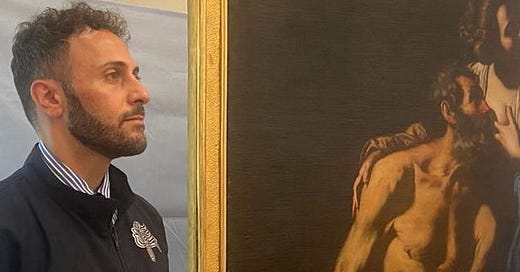There’s a reason Donna Leon’s Venetian crime novels have never been translated into Italian: you get the same information from reading the Italian press, or from reading the art press anywhere. There’s a character type in the Brunetti novels that’s easily recognizable in real life: the clever, hard-working Servant of the State, hard-working and clever in the realm of appearances and self-promotion only. Such people are not corrupt in the sordid, American individualistic sense but rather in the sense of the total identification of their interests with the interests of a self-serving state or enterprise
Let’s change the subject. Let’s talk about Artemisia Gentileschi. If it is a Gentileschi. And it must be because the State in Italy says so, and the State has an interest in saying so because if the painting titled Roman Charity’s what the State says it is, then the owners, who originally planned to put Gentileschi’s painting up at auction in Austria, can be prevented from taking it out of Italy as a cultural treasure. Better yet: if the State can prove the owners knew the painting was a Gentileschi and not merely “attributed to Artemisia Gentileschi and/or Onofrio Palumbo, formerly attributed to Massimo Stanzione” as the owners claim, then the State confiscates the painting and sticks it in a museum in Bari, Italy, a town that’s in some need of tourist attractions.1
Except, there’s another possibility left unstated by the State: that the painting can’t be attributed to Gentileschi with any certainty; and that the owners were correct in their description. The State claims the owners were attempting to “maximize their economic benefits by selling the work abroad,” but I fail to see how they could maximize their benefits by arguing it wasn’t a Gentileschi to begin with.2
The State, which seems most comfortable with headline-grabbing fantasies of rediscovered masterpieces, insists that the attribution is “certain.” There is no such thing. They say you can’t prove a negative but when assessing art a negative is just about the only thing you can prove.
Separated at Birth?
But then, as surely as the State must assert its monopoly on violence, the State must assert its authority to determine the exchange value of art in the same way that it asserts its authority to fix the exchange value of species; think of the State as the Jerome Powell of the Art World.
As well as the Jerome Powell tout court, because the two functions, determining the value of species and determining the worth of Art, are closely connected, at least in Europe. In the USA the function of determining the value of Art is left, mostly, to the private sector, and this difference, arguably, is far more determining of art policies than the question of private or public support for the arts.
It's a long story and I’ve talked about it elsewhere. It started in the French Revolution, when the State was recklessly printing paper money (assignats) that crashed in value, until the State decided to exchange assignats for property confiscated from exiles and designated enemies of the State; pretty soon the State was in the business of creating enemies of the State in order to confiscate their property, some of which consisted of artworks whose exchange value needed to be determined, at which point two interlocked criteria entered the picture, the first being “aesthetic value” and the other the presumed social value of objects bearing aesthetic value. Museums, then, became the instrument for the exploitation of aesthetic value for the benefit of the People, a poor substitute for the redistribution of confiscated wealth promised by the Revolutionary State.3 Bari may not be known for its aesthetic appeal, but it is a major transit point for immigrants and others from the Eastern Mediterranean, so the suggestion that Gentileschi’s painting is being saved from unpatriotic owners similar to the exiled aristocrats of the French Revolution is plain, given the anti-immigrant, nationalistic sentiments exacerbated daily by the State and those who would become the State in Italy.
But enough of this. Let’s talk about masterpieces.
Taylor Dafoe. “Italian Authorities Blocked the Sale of an Artemisia Gentileschi Painting in Austria, Saying Its Owners Lied to Export It.” Artnet, July 20, 2022. https://news.artnet.com/art-world/italian-artemisia-gentileschi-painting-export-2149963
“per massimizzare il ricavo economico derivante dalla vendita all’estero dell’opera.” Bari: recuperato dai Carabinieri TPC e rimpatriato dall’Austria eccezionale dipinto seicentesco di Artemisia Gentileschi.” Italia Nostra, 19 Luglio 2022. https://www.italianostra.org/vi-segnaliamo/bari-recuperato-dai-carabinieri-tp-e-rimpatriato-dallaustria-eccezionale-dipinto-seicentesco-di-artemisia-gentileschi/
Paul Werner. “Elogio del Vandalismo / In Praise of Vandalism.” Lectio Magistralis, MACRO Asilo – Museum of Contemporary Art in Rome, December 1, 2018. https://www.macroasilo.it/media/paul-werner-elogio-del-vandalismo-000




